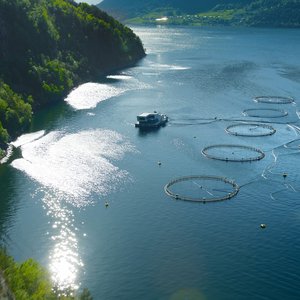The fatty acid DHA improves survival and development of Atlantic halibut larvae
Bottlenecks in halibut farming are related to insufficient supply of important nutrients. Two feeding trials at NIFES in collaboration with the Institute of Marine Research, Austevoll Havbruksstasjon, Norway, suggests for the first time minimum levels of the marine fatty acid DHA needed for good survival and normal pigmentation.
8% DHA for good survival
In a feeding trial, a group of Atlantic halibut larvae was fed Artemia enriched with a high content of the marine fatty acids EPA (eicosapentaenoic acid) and DHA (docosahexaenoic acid), provided as an emulsion. Another group was given Artemia enriched with fish oil. Enriched Artemia from the first group contained 7.5 % DHA of total fatty acids, while the other group contained 4.1 % DHA of total fatty acids.
The Atlantic halibut larvae that were fed Artemia which contained about 8% DHA had an increased survival rate of 39%, compared to 12% survival rate of the other group. Also, growth was better in the first group.
“This tells us that Atlantic halibut larvae need at least 8 % DHA for a good survival rate and growth”, says Kristin Hamre at the Aquaculture Nutrition Research Programme at the National Institute of Nutrition and Seafood Research (NIFES).
In another feeding trial, two groups of Atlantic halibut larvae were fed Artemia enriched with either 9.4 % DHA or 12.5% DHA provided as emulsions. 46 % of the Atlantic halibut larvae which were fed Artemia from the first group showed normal pigmentation, while a total of 77 % of the Atlantic halibut larvae from the second group had normal pigmentation, says Hamre.
An elevated content of DHA leads to a better pigmentation. These results suggest that Atlantic halibut larvae may need as much as 15 % DHA for normal pigmentation, says Hamre, and adds that the EPA and ARA (aracidonic acid) ratio in the Artemia was 3.5 % in both groups. The relationship between EPA and ARA also affects pigmentation. In this trial survival rate was similar in the two groups, and at the same level as the first trial referred to in this article.
Artemia and enrichment
Atlantic halibut larvae are only 12 millimetres and quite immature at hatching. In this life stage, until they reach 45 days of age, the larvae depend on nutrient supply from the yolk sac. Larvae from 45 to around 100 days are not capable of eating dry feed, and are therefore usually fed the crustacean Artemia. In order for the crustaceans to contain the nutrients the halibut larvae need, Artemia is supplied with food in the form of algae with a specific nutrient composition. This is called to enrich the Artemia. Work is in progress to reduce the time the larvae depends on Artemia by developing satisfactory dry feed and feeding regimes. Improved dry feed already enables some fish farms to wean their Altantic halibut larvae earlier than by 100 days of age.
For more information contact Kristin Hamre, researcher at the Aquaculture Nutrition Programme, NIFES.
Based on the scientific articles:
1. Hamre, K., Harboe, T. (2008) Artemia enriched with high n-3 HUFA may give a large improvement in performance of Atlantic halibut (Hippoglossus hippoglossus L.) larvae. Aquaculture, 277, 239–243.
2. Hamre, K., Harboe, T. (2008) Critical levels of essential fatty acids for normal pigmentation in Atlantic halibut (Hippoglossus hippoglossus L.) larvae. Aquaculture 277, 101-108.







